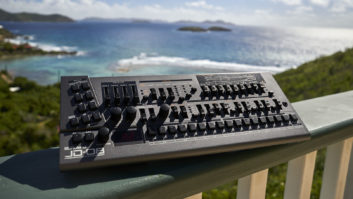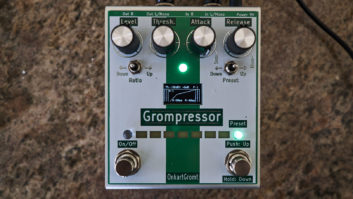
| MIX VERDICT |
| “At $299, the DM-7 set is definitely a steal, as I fully expected it to cost double that and still be a really good deal.” |
| COMPANY: PreSonus PRODUCT: DM-7 drum mic set WEBSITE: www.presonus.com PRICE: $299 PROS: • Very good sonic performance. • Straightforward designs. • Low price. CONS: • OH-2s not level-matched. • ST-4 connectors are backward for right-angle mic cables. |
Many manufacturers offer drum mic sets these days, with many of them sounding good and quite affordable, too. When I heard that Alan Parsons was an endorser of PreSonus’ DM-7 (specifically as an end-user endorser, not a paid endorser), I knew I had to hear this kit for myself.
A light-duty aluminum carrying case houses the entire DM-7 kit—one BD-1 dynamic kick drum mic, four ST-4 dynamics for snare and tom-toms, two OH-2 pencil condenser mics for overheads, two clips and windscreens for the OH-2s (the BD-1 and ST-4s have mic stand adaptors built in)—which is only cables, a short stand and a couple of overhead booms shy of a complete drum-kit recording package. The four ST-4s come with drum-rim clips that use the “European to American,” small-to-large thread adaptors.
THE KIT ON THE KIT

For some proper testing, I knew I needed a drummer with serious chops, a wide range of styles, a good ear and a nice kit, too. I was fortunate that Noel White was able to stop by. Noel has put in many years and countless gigs drum-tech’ing and in-ear mixing for A-list performers like Herbie Hancock, Sting, Josh Freese and Vinnie Colaiuta. Noel has refined ears and skills for days from running a studio business, as well.
We started out with my house kit, a five-piece mixed set of oversized Ludwigs, Mapex and Premieres for a big-drum rock sound. We set up in my A-room, a 16 x 12 x 9-foot room with plenty of diffusion, absorption and corner bass trapping for a well-balanced, small-room sound. Preamps were my typical Cranborne Camden 500s (kick/snare, but without the use of any harmonic enhancement), True Precision 8 (toms), and AMS Neve 4081 (overheads, with no EQ and just a little FET compression). I also recorded with a few more mics—outside kick, snare bottom, hi-hat, room ribbon—to see whether the DM-7 set could play well with others and complete my usual drum sound.
Mounting the DM-7 set was quick, with no difficulties from faulty accessories. The cardioid BD-1 screwed firmly onto my kick stand and wasn’t too large or heavy, so getting through the kick’s resonant head hole was easy and we got on-axis with beater placement with little effort. The cardioid ST-4 mounted on snare without much placement flexibility allowed by the clip/mount, but in a spot that worked fine. Aimed more to my liking on tom-toms, the ST-4’s clips don’t allow much range, but got the job done. The OH-2’s clips weren’t as snug as I’d like (a little gaffer’s tape might be wise for bouncy stages/risers), but they did hold firm through the entire session.
All the mics had nice snug XLR connections, but the ST-4’s proved to be a problem with my right-angle, tight-spot XLR mic cables that I use for toms. It seems the ST-4’s connectors are mounted upside-down, meaning that right-angle cables point toward the drum center, not away from it like they should. Straight-connector XLR cables are therefore recommended for the ST-4s and will likely not be a problem, except for really tight drum kit setups (i.e., jazz) with low-mounted cymbals.
BRING IN THE DRUMMER
Noel started laying down some beats, and it was clear from the start that this mic kit has plenty of punch and an overall full/warm presentation. Playback without any EQ or processing showed a largely neutral drum sound; tight kick bottom with a nice little snap up-top (reminiscent of a Shure Beta 52, but flatter); a “definitely not a 57” snare tone that was a little compressed, scooping some mid-mids out but without a 57’s high-mid boost (reminiscent of an sE V7); mid-focused toms with just enough top-end definition but without cymbal bleed problems (reminiscent of Sennheiser 604s); and crisp and lean overheads that had some mids artfully carved out and plenty way up-top, not quite the “too much sizzle” as is often found with budget small-diaphragm condensers.
There was quite a level difference between the two OH-2s, right around 5 dB, which was a cause for concern “matching-wise” but isn’t a real-world problem. After all, that’s what input gain pots are for. The OH-2s were plenty sensitive, requiring only 20 dB of gain on overheads, and sounded matched both frequency- and dynamics-wise, so this isn’t much of a practical issue.
Vanguard Audio Labs V13 gen2 Microphone – A Real-World Review
Flare Calmer Earplugs – A Real-World Review
I then applied all the usual techniques that you would use on a rock drum sound (compression, EQ, reverb, bus compression, saturation, and so on) and found the kit sounding fabulous. I added in the extra non-PreSonus mics, including the room ribbon, snare bottom, kick out, and found a totally finished sound that I could easily sell a client on. I turned to Noel for his opinion, and he was right there with me—satisfied with the sound of the raw mics and more than pleasantly surprised with the processed, “finished sound.”
We also tried out Noel’s Gretsch kit, which produced similar results to my kit; the DM-7 sounds were natural, versatile and more than adequate. Noel offered this about the overheads: “Not remotely harsh and a very nice soft presence above 4k. They sounded so nice I played cymbals more than I normally do, feeling very inspired how well the bells and softer, nuanced stuff just sat so nicely with the rest of the kit mics.”
THE FINAL MIX
It was difficult, but I managed to do almost this whole review without learning the cost of the DM-7 set—that is, until I finished recording with Noel and curiosity got the best of us. At $299, the DM-7 set is definitely a steal, as I fully expected it to cost double that and still be a really good deal.
Aside from two factors (the OH-2s not matching in output level and the upside-down ST-4 connectors), this is a completely satisfying kit in-use that could capture a competent rock, pop, country, hip-hop or jazz drum tone, live or studio. Contained all in one small, portable case, the DM-7 kit is a great solution for touring bands on a budget, or home recordists with few funds and big dreams. As Noel said, “If they hold up on the road as well as they sounded at Catalyst, I would recommend them for any studio or touring band on a budget.”
It deserves mention that this mic kit offers versatility beyond drums, as I would expect good results with percussion, pianos, electric guitars, basses and acoustic instruments, too. Throw in a large-diaphragm condenser and a ribbon mic and you’d have all the bases covered for recording just about anything. For that matter…
Considering how well the DM-7 set performed with the help of a few extra mics, I have to recommend that PreSonus make a deluxe DM- 10 kit, with two more OH-2s (room, ride, hat, snare bottom, etc.) and another BD-1 (double kicks, extra floor toms, snare bottom, bass guitar, etc.). That would be a whole lot of drum miking flexibility, sonic quality, affordability and portability all in one package. I’ll bet Alan Parsons would be pleased; I sure would be.
PRODUCT SUMMARY
COMPANY: PreSonus
PRODUCT: DM-7 drum mic set
WEBSITE: www.presonus.com
PRICE: $299
PROS: Very good sonic performance, straightforward designs, low price
CONS: OH-2s not level-matched, ST-4 connectors are backward for right-angle mic cables







